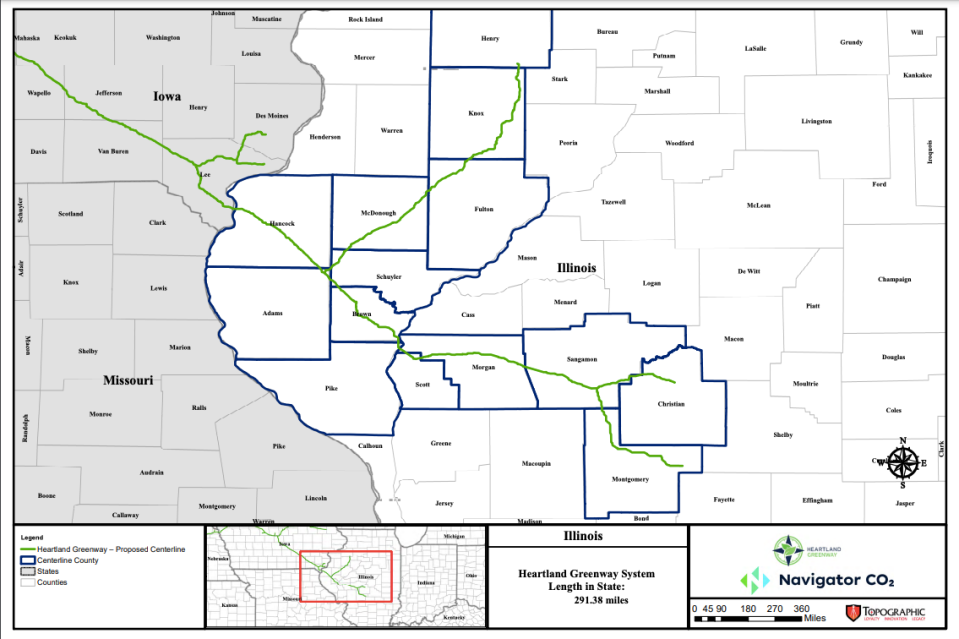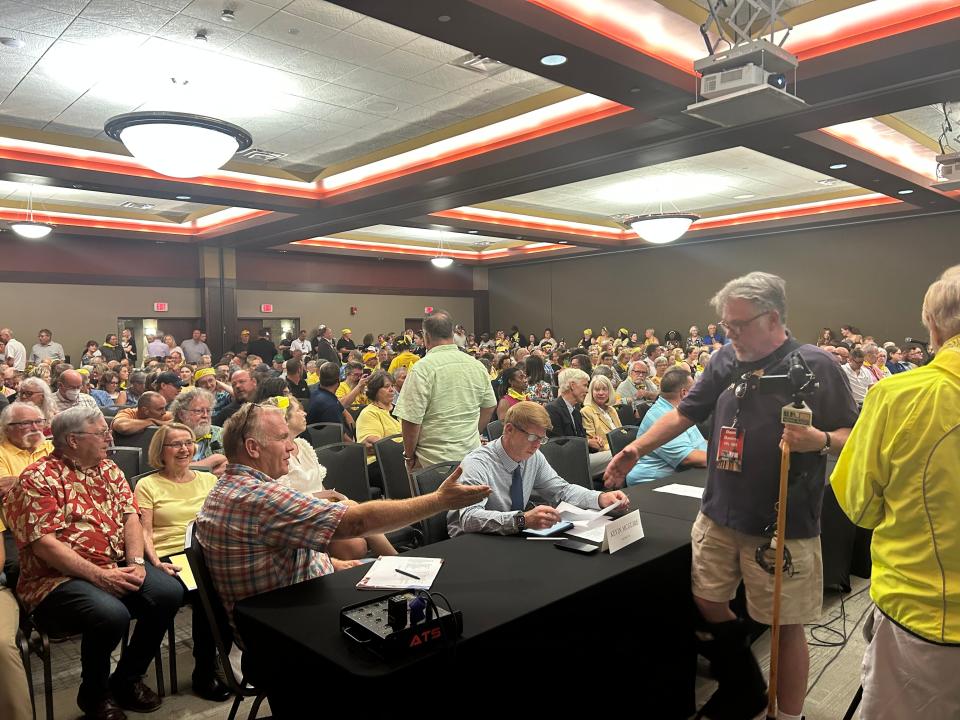Safety concerns raised at packed hearing on Navigator's CO2 pipeline plan
As a public meeting Monday evening revealed, finding common ground on a multi-state carbon dioxide pipeline running through Sangamon County remains a problem both figuratively and literally.
Coming to Springfield from Nebraska, Navigator Heartland Greenway LLC attempted to sell a standing room audience on its proposed pipeline running through 292 miles in the state. That task has proven difficult in preceding months and the meeting held by the county Zoning and Land Use Committee continued that trend.
Approximately 39 miles of pipeline collecting emissions from ethanol plants and storing them underground would run through the county, hitting portions of nine townships. Opponents are concerned a potential pipeline burst with this proximity to towns such as New Berlin and Glenarm could lead to a public health crisis exceeding what was seen earlier this year during the I-55 dust storm.

This fear, along with belief that existing state and federal regulations are inadequate, has caused several counties to issue moratoriums against CO2 pipeline construction. As of June, Navigator has also only received 13.4% of the right-of-way easement agreements statewide and 5.2% in the county according to its own data.
"This proposal is not the best interest of Sangamon County," Glenarm resident Kathleen Campbell said during the meeting held at the Bank of Springfield Center.
Most of Navigator's presentation focused on its safety efforts for the pipeline, where in addition to 24/7 monitoring and a lockdown system that would prevent a burst from spreading further up or down the line, there will be bi-weekly air monitoring by plane or drone to check in for any weather disruptions.
"So we have a control room that's monitored 24 hours a day, seven days a week, 365 days a year by qualified personnel, they get a signal that comes in, they're able to say, 'Hey, we may have an event happening right here,'" said Chris Brown, Navigator vice president of capital projects. "At that point, they will follow their emergency manual procedures along with the counties if it involves getting them involved."
Getting those counties involved, Navigator said it has held several meeting with emergency management agencies and plans to continue those conversations. They are in the process of crafting emergency response plans with each of the 12 counties the pipeline would run through in Illinois, with Brown saying these plans will be different for each county.
"You can't do everyone's the same because they're going to have different power settings, different locations, different hospitals," he said.
Sangamon County director of the Office of Emergency Management Bill Lee said it will likely take at least a year to develop a response plan, this being challenged since Navigator has not finalized its route. The company has also promised to pay for training, although how much funding it will commit is not certain.
Lee added the county currently lacks sufficient personal protective equipment or a fleet of vehicles that could drive through a plume of CO2. The kind of vehicle needed in the case of a pipeline leak has to be an electric since a combustion engine cannot operate if carbon dioxide displaces oxygen in the air.
Navigator's petition has been before the Illinois Commerce Commission since late February, who is in the middle of an 11-month review before ultimately making a decision on the pipeline. Already through, some ICC staff has recommended the commission to not approve.
More: CO2 pipelines, utility rate requests await new Illinois Commerce Commission chair
Among those providing testimony last month, ICC senior gas engineer Mark Maple cited those low amounts of secured easement agreements and a lack of experience from Navigator in building CO2-specific pipelines as his reasons to oppose. The company has also yet to establish a sequestration site - where the liquified CO2 would be stored underground - but has selected potential sites in either Christian or Montgomery counties.
"Without a sequestration facility in place and the end point being uncertain, the entire route remains in flux, and consequently, in my opinion, it is not a benefit to the citizens of Illinois nor in the public interest," Maple's testimony reads.
Financial incentives or financial hits?
While the majority of those speaking during the hours-long meeting rose in opposition, several members of pipefitters unions both local and visiting announced their backing.
Illinois Chamber of Commerce senior vice president of government affairs Clark Kaericher touted the economic benefits, specifically mentioning how the capture of emissions at 30 ethanol plants will bring-in potential billions per year and the creation of 3,500 jobs.
"I understand why some of you might initially be afraid of this project, I was too before I dove into it," the Chatham resident roughly a mile away from the proposed pipeline said. "But we can't allow that fear to reject the science, we can't allow that fear to reject strict PHSMA (United States Pipeline and Hazardous Materials Safety Administration) standards."
Navigator plans to exceed standards set by PHSMA, but those guidelines are currently being revised prompted by a 2020 pipeline burst in Satartia, Mississippi. No deaths were reported in the incident, but emergency personnel were forced to evacuate about 200 residents and 45 people sought medical attention.

"The current regulations for constructions are essentially the same of those that were used to construct the pipeline in Mississippi," said JD Sudeth, president of the Sangamon County Farm Bureau who is formally opposed to the pipeline. "Thus, we cannot allow this pipeline to be constructed in the same manner as the Mississippi pipeline that failed."
Additionally, opponents say property values and agricultural yields will drop and those jobs that are tied to the project are seen as temporary at best.
If the ICC moves forward with the project, the county could receive payment from Navigator. Joel Benoit, chief of the civil division in the Sangamon County state’s attorney’s office, discussed the form of payment the county would receive through two project development agreements, one pertaining to how much the county receives per mile of pipeline and the other regarding each operating sequestration well.
More: Protests mounting over proposed CO2 pipelines cutting across Peoria, Tazewell counties
The county could receive up to $48 million if it "provides positive assistance as necessary," per the PDAs. What that means specifically was not certain to Benoit.
"Generally, for a contract to be enforceable its terms must be definite," he said, calling for amended agreements between Navigator and the county. "In my opinion, the requirement to 'provide positive assistance as necessary' does not meet this standard. I mean, when I read, I just think 'What is positive assistance?' and what is 'as necessary?'"
Contact Patrick Keck: 312-549-9340, pkeck@gannett.com, twitter.com/@pkeckreporter.
This article originally appeared on State Journal-Register: Hundreds attend public hearing on Navigator CO2 pipeline

